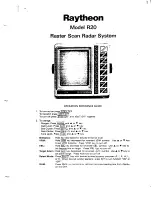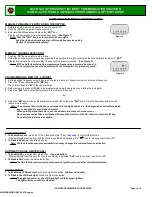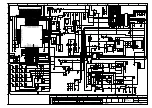
MM-010019-001, Rev. B
14
3 INTRODUCTION
3.1 GENERAL
DESCRIPTION
The M7200 mobile radio is a high-performance full-duplex dual-band digital mobile radio. It can operate
on 700 MHz and 800 MHz OpenSky trunked radio networks using the OpenSky Trunking Protocol
(OTP). In the future, the radio will also operate on 800 MHz Enhanced Digital Access Communications
System (EDACS) trunked radio networks, and 800 MHz APCO Project 25 phase I compliant Common
Air Interface (P25 CAI) trunked radio networks. Other future operating modes include talk-around
communications in accordance with the APCO Project 25 phase I standard, and conventional FM
repeater-based and FM talk-around voice communications in accordance with the TIA/EIA-603
conventional land-mobile radio standard. The radio is illustrated in Figure 5-2 on page 22.
The initial release of this radio only supports operations on 700 MHz and 800 MHz
OpenSky trunked radio networks. Later releases of the radio will add other modes to
support other trunked radio networks, and conventional FM repeater-based and FM
talk-around voice communication modes.
The M7200 is designed to operate in a mobile environment, typically within a motor vehicle. It must be
connected to an external transmit/receive antenna such as one mounted to the vehicle’s rooftop or trunk
lid. In high-power half-duplex mode, the radio’s 800 MHz RF transmit output power is rated at 15 watts
minimum. The power limit for 700 MHz interoperability channel operations is 300 milliwatts maximum.
This power limit guarantees the 2-watt ERP (effective radiated power) limit of the 700 MHz
interoperability narrowband channels is not exceeded when the radio is connected to a 6 dB gain antenna.
Several different types of external-mount antennas are approved and available for use with the radio, as
listed in Table 1-1 and Table 4-2.
The radio is designed for remote mounting in a motor vehicle’s trunk, or some other preferably
unoccupied section in a vehicle, such as a fire truck’s equipment shelf. It is remotely controlled by up to
five (5) control heads connected to it via 3-wire Controller Area Network (CAN) cables. Between the
radio and control head(s), the CAN link carries digitized microphone and speaker audio, controlling data
such as button presses and radio messages, and user data such as that for a mobile data terminal connected
to serial port of the radio or control head. For proper operation, the CAN link must be terminated
appropriately on each end. In multiple control head installations, two or more control heads are
interconnected to the mobile radio in a series (daisy-chain) fashion via CAN link cables. Up to five (5)
control heads can be connected to an M7200 in a multiple control head installation.
Control heads used with the M7200 radio include the CH-721 Scan and the CH-721 System model
control heads. See Figure 9-1 (page 37) through Figure 9-3. Both heads feature a large 3-line graphical
vacuum-florescent display, front panel controls and buttons for user control of the mobile radio, an
internal high-power audio amplifier to drive an externally-connected speaker, and a front panel
microphone connector. The CH-721 System control head also has a 12-button numeric keypad that
provides Dual-Tone Multi-Frequency (DTMF) functionality and easier operator system/group selection
control at the control head’s front panel.
As shown in Figure 9-3 on page 38, the CH-721 Scan and System model control heads have several
connectors located on the rear panel. These connectors include a DC power connector, two (2) CAN port
connectors used for CAN link interconnections, an external speaker connector, a 9-pin serial port
connector for connecting optional equipment such as a mobile data terminal, and a 25-pin multi-function
connector.















































